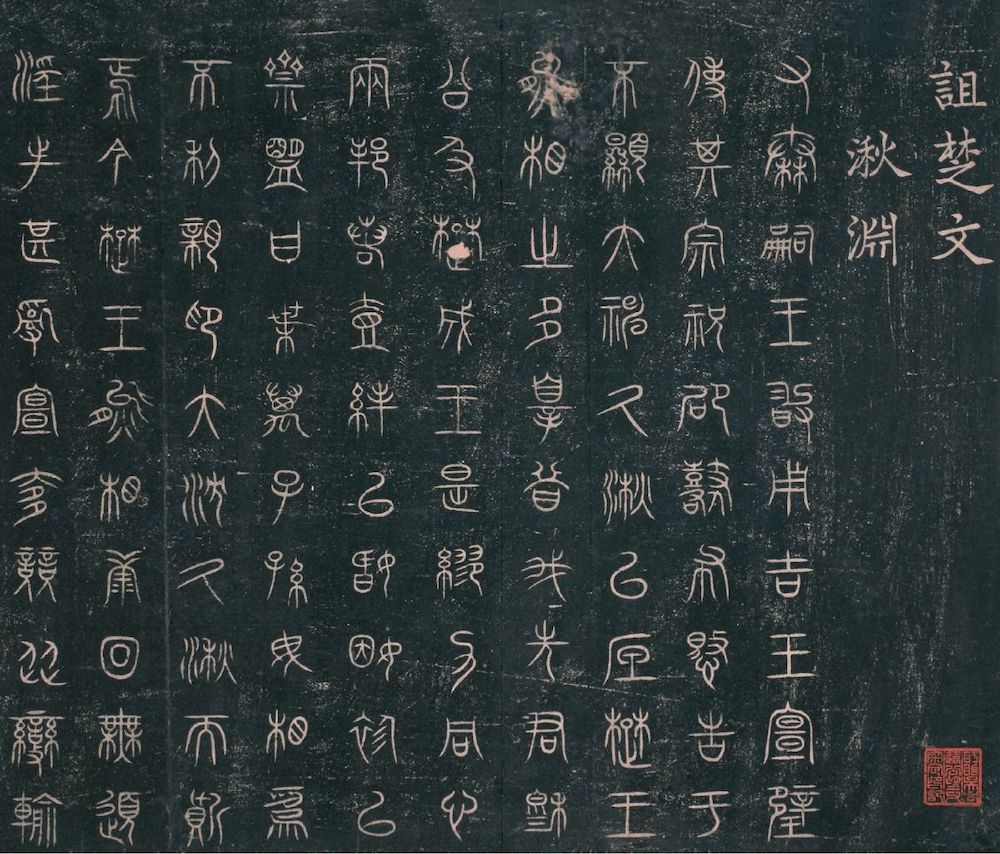The "Curses against Chu" (Zu Chu wen 詛楚文) is a collection of three texts produced during the late Warring States period 戰國 (5th cent.-221 BCE) and incised into stone. It is also known as Si Wu Xian Da Qiu wen 祀巫咸大湫文 or Qiu Yuan 湫淵 because the context was a sacrifice of the state of Qin 秦 to the river deities Wu Xian 巫咸, Da Chen Jue Qiu 大沈厥湫 (or Da Shen Da Qiu 大沈大湫, also called Qiu Yuan), and Ya Tuo 亞駝 delivered with the hope to defeat the army of Chu 楚 and reconquer border towns formerly (in 313 BCE) occupied by Chu.
During the Northern Song period 北宋 (960-1126), around 1060, a stone with the inscription Wu Xian wen 巫咸文 was discovered that was buried on the ground where Kaiyuan Monastery 開元寺 was built, in Fengxiang 鳳翔, Shaanxi. The inscription consists of 326 words or characters, The second one, discovered a few years later in Chaonaqiu 朝那湫, close to River Wei 渭水, Shaanxi, has a length of 318 words. The third stone with the inscription Ya Tuo wen 亞駝文, with a length of 325 characters, was discovered in Luoyang 洛陽 on the land of a certain Liu Chen 劉忱. It came into the possession of Cao Ting 蔡挺. The original, square stones are long lost, but rubbings and copies of rubbings of the first two stones have survived.
The inscriptions were written in ancient large seal script, and were much admired by contemporary calligraphers, and thus included in the model calligraphy boards Jiang tie 絳帖 and Ru tie 汝帖. The inscription Yatuo wen 亞駝文, however, was not included.
The texts of the three inscriptions are identical, barring a few words like the place where the sacrifice was conducted, and the names of the spirits or deities. Some scholars think the Ya Tuo inscription is a forgery of a later date. Concerning the date of compilation, Dong Yong 董逌 (early 12th cent.) and Wang Bai 王柏 (1197-1274) believed them to be produced under the reign of King Qingxiang 楚頃襄王 (r. 299-263) of Chu, but Ouyang Xiu 歐陽修 (1007-1072) identified them as products of the era of King Huai 楚懷王 (r. 329-299) of Chu. The poetry collection Guwenyuan 古文苑 includes the texts of the stones, dating them to the reign-period of King Huiwen 秦惠文王 (r. 338-311) of Qin. The modern scholar Guo Moruo 郭沫若 (1892-1978) dated them precisely to the year 312.
The beauty of the large-seal-script characters influenced calligraphers from the Song 宋 (960-1279) and Yuan 元 (1279-1368) periods like Yang Huan 楊桓 (1234-1299) or Zhao Mengfu 趙孟頫 (1254-1322). Su Shi wrote a famous poem on the inscriptions.
 |
Rubbing from the Yuan period produced during the 1340s-1350s by an anonymous person. Rubbings of the three stones were published in a book that included Ouyang Xiu's 歐陽修 Qin si Wu Xian shen wen 秦祀巫咸神文, Su Shi's 蘇軾 (1037-1101) poem Zu Chu wen shi 詛楚文詩, Wang Bai's 王柏 (1197-1274) poems Zu Chu wen ci bing xu 詛楚文辭并序, and Zhang Boqi's 周伯琦 (1298-1369) phonetic annotations Zu Chu wen yinshi 詛楚文音釋. The book was originally owned by Zhu Wenjun 朱文鈞 (1882-1937) and later acquired by the Palace Museum (Gugong Bowuyuan 故宮博物院). From Zijicheng 紫禁城, 2021:8: 10-11. |